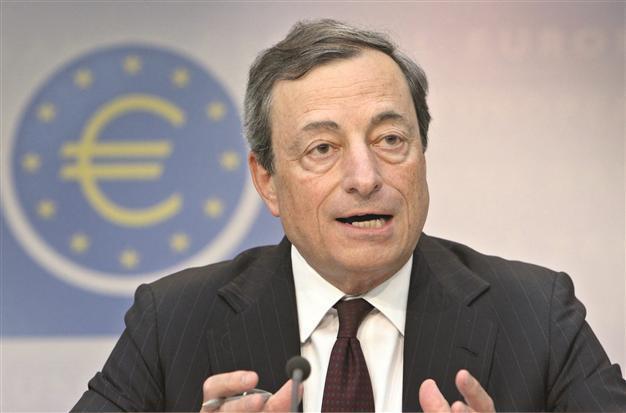ECB leaves rates amid recession-end hopes
FRANKFURT - The Associated Press

European Central Bank Chief Mario Draghi speaks at a news conference in this file photo. The bank didn’t touch interest rates due to over exiting recession in the near future, prompted by the bright figures announced. AFP photo
The European Central Bank left interest rates at a record low 0.5 percent yesterday following signs of a tentative recovery in the eurozone economy.
Stronger economic reports in the past few days support the ECB’s expectations of a pick-up later this year, though the policy options are complicated by market responses to the U.S. Federal Reserve’s plans to slow its economic stimulus programme.
The ECB reacted last month to market turmoil sparked by the Fed’s exit plan by breaking with precedent and offering forward guidance on rates, saying it may yet cut further.
Individual policymakers’ interpretations of that guidance over the last month have blurred the message, however, with Bundesbank chief Jens Weidmann insisting the ECB had not “tied itself to the mast”. The result is that the initiative has proven only partially successful in calming markets and offsetting fallout from the Fed’s stance.
On July 31, the Fed said it would keep buying $85 billion in mortgage and Treasury securities per month in an effort to strengthen the economy, and gave a more dovish tilt to its post-meeting statement.
“That was in line with expectations,” Rabobank economist Elwin de Groot said of the decision to leave rates unchanged, almost universally expected in a Reuters poll.
“At this stage, we’ve seen several indicators improving a little bit. Today, the update on the PMI surveys confirmed that point,” he said of closely watched business surveys, which showed that last month euro zone manufacturing grew for the first time in two years. Unemployment in the 17-country bloc sharing the euro fell for the first time in more than two years in June. But lending to firms is still declining in the euro zone and is especially weak across the bloc’s troubled debtor countries, which could keep calls for lower policy rates alive.
“There was no immediate pressure for the ECB to do more,” de Groot said, but added: “There is a lot of uncertainty and if the economic recovery does not become more visible in the second half, they will be forced to do more.”
Guidance on guidanceIn a letter to a European parliamentarian, dated July 31 and published yesterday, Draghi said the central bank’s policy was “highly accommodative”.
“We expect that our monetary policy will support the recovery, which we expect to begin in the second half of the year,” he said.
In addition to the growth outlook, a focus at Thursday’s news conference will be on discussion about publishing the minutes of Council meetings, and the forward guidance message.
Draghi said on JUly 30 he wanted to begin publishing the minutes of ECB meetings, which until now have been kept secret, and Jens Weidmann also favours the move.
However, such a move to increase transparency is sure to meet resistance from some ECB policymakers, who fear the move could open them up to political pressure from national governments, and a change would take time to agree.
Explaining the ECB’s expectation that it would keep rates at record lows for an “extended period”, Draghi gave little away last month when pressed on the timeframe, saying it was “not six months, it’s not 12 months. It’s an extended period of time.”
